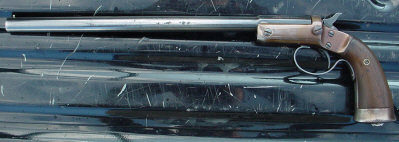The Stevens Off-Hand Shotgun and Auto-Shot pistol
Marshall Williams

|
The little single shot Stevens is an interesting collectible, although not particularly valuable compared to the Marble’s Game Getter. The one pictured is either an "Off-Hand Shotgun" or an "Auto-Shot." Both are essentially the same. Stevens made an estimated 20,000-25,000 of the "Off-Hand Shotgun" between 1923 and 1929, and an estimated 2,000 more of the "Auto-Shot" between 1923 and 1934. The large frame also is called the "No. 35." The earlier name refers to the Stevens "Off Hand" target pistol frame on which the shotgun was built. The target pistol had a rifled barrel with conventional sights and was chambered for various pistol calibers. The rifled barrel gun is not covered by the National Firearms Act of 1934 (NFA, see below) and is more common. The "Auto" part of the Auto-Shot name stems from the small gun’s utility in an automobile rather than any automatic feature of its simple and entirely manual action. (The Ithaca Gun Company made a splendid little double barrel pistol in 20 and 28 gauges and called it the "Auto-Burglar" model. The name was chosen to emphasize that the short pistol shotgun was convenient in a car and useful for shooting burglars rather than for use by burglars traveling by auto, although the other meaning would make sense.)
The three inch .410 shotgun shell had appeared by 1934, and some of the last guns manufactured may have had three inch chambers. However, the recoil of even the 2 ˝ inch shell from this relatively light model would have been comparable to the modern .41 magnum. Assuming a 2 pound hand gun, and the little Stevens may weigh less, the recoil energy of a 2 ˝ inch shell loaded with ˝ oz. of shot at 1100 fps from the short barrel would be about 10.5 ft. lbs. The recoil energy of a 2 3/4 lb S&W .41 magnum using at 210 grain bullet at 1300 fps would be 10.3 ft. lbs. The three inch shell would have substantially exceeded that. These guns were the end of a long line. Stevens started manufacture of single shot pistols during the 1870s. I could find no date for the first smooth bore guns intended for shot and ball, but the type appeared in some variety before the turn of the 20th. Century. The earliest Stevens guns were called "Pocket Shotguns." They can be found with detachable wire or skeleton stocks, and eight inch barrels probably were most common. The longer 12 1/4 inch barrel was added about 1910 in order to comply with the laws of some U. S. States which forbade shotguns with barrels less than 12 inches in length. Earlier but similar Stevens guns were chambered for the .44 shot and ball cartridge or the similar if not identical .44 XL. These cartridges has chamber dimensions similar to the .44-40 Winchester, but were loaded either with shot or a single 115 grain round ball. The reason for the round ball is that a standard bullet out of a smooth bore barrel would tumble in flight and be inaccurate. A round ball can not tumble and would give satisfactory practical accuracy at short ranges, perhaps to 25 or even 50 yards. The shot cartridges came in a variety of types which included an elongated case with a crimp closure and standard length cases containing a bullet-shaped wood or paper capsule containing the shot. Based on information in Flayderman's Guide to Antique American
Firearms, the Stevens Auto Shot pistol shotgun differs from the Stevens
Off Hand Shotgun in having a simple stamped trigger guard rather than a
cast iron one. These little shotguns were popular "pot guns" ( from the expression "shooting for the [cooking] pot") for farmers or woodsmen who carried them to kill small game that they might encounter while going about their daily tasks out of doors. The tiny shot charges would easily take rabbits, squirrels, or grouse at 12 or 15 yards, and the ball cartridge would suit bigger game probably to include even deer, although by modern standards it would be considered too light. The NFA effectively ended production of smooth bore pistols in the United States by putting a prohibitory tax on smooth bore guns with barrels less than 18 inches long or an overall length of less than 26 inches. It is a great shame as they are unlikely choices for the likes of John Dillinger and Baby Face Nelson, but are quite useful as well as interesting. Please note that in the U.S., if these little guns are not properly registered, their possession is a felony and the guns are subject to seizure. Most of these little guns that I have seen were in police collections of confiscated guns. Further information can be found on the BATF website www.atf.treas.gov. and http://www.atf.gov/firearms/curios/sec4.htm For ALOOF, Marshall Williams |